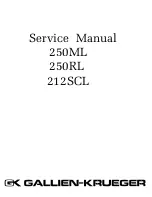
C947 & R910 set the free running frequency of the internal oscillator of U902, until
synchronization to the master clock is achieved. The deadtime between when one IGBT
turns off and the other one turns on is set by R911. During startup C917 forms a time
constant with R911 that determines the rate at which the duty cycle increases from 0%
(off) at startup to the final duty cycle of approximately 40% on each switch when it is
running. the duty cycle is also forced to zero when either comparator section of U903
goes low. Transistors Q901, Q902, Q904, and Q905 increases the current available to
drive IGBTs Q903 and Q906 over what U902 can source or sink.
Low voltage Power Supply
A regulated and noise +5V supply is required by the APM/Display and U1. This is
generated with a buck topology switching power supply operating from the “+LV” rail
and switches at 192 kHz when synchronized. Q908, D911, L905, C950, and C940
process the power, and U905 a TL494 control IC contains the control loop and
modulator. The free running oscillator frequency is set by R942 which controls the
charging current of C944. The +5V output is filtered by R938, and C941 before it is fed
directly into the mom-inverting input (U905 pin#1) of the TL494 internal error amp.
This error amp is a non-inverting stage, and is compensated by components R940, R939,
and C942. A second error amp is used as a 7.5V under voltage lockout is formed by
R943 & R944. Its purpose is to prevent the converter from starting when the supply
voltage is too low to for the in5V reference (U905 pin#14) to maintain regulation.
P channel MOSFET Q908 is turned on via R937 & R936 when the gate driver output
(U905 pin#8&11) of the control IC pulls low.
Soft Start Relay control
The softstart relay (K901) provides an alternate high current path around the power
switch (S901) and the inrush limiting PTC (RT901). This maximizes the rail voltage
available for improved power output compared to simpler NTC inrush limiting designs.
The microprocessor U706 controls the softstart relay via common base transistor Q911
which supplies base current to Q912 which switches the relay on and off. D915 is
present to catch the flyback voltage coming off K901 as it de-energizes.
Softstart relay (K901) engages once the microprocessor determines that the +Vcc and –
Vcc rails are with their nominal range. If the rails are either too high or too low the
softstart relay will disengage to protect the power supply and amplifier channels.
Temperature sensor circuit
The NTC temperature sensor RT1 measures the temperature of the main secondary
diodes (D905-D908) which are mounted to a heatsink (HS3). This sensor is a surface
mount 0603 NTC that picks up the heatsink temperature near diode D906.
Synchronization circuit and AC Buss generation
The synchronization circuit forces the +5V supply to switch at 192 kHz, which is half of
the amplifier stages switching frequency. It also forces the main supply to switch at 96
Summary of Contents for XLS 1000 Series
Page 1: ...XLS1000 2500 Service Manual 142195 1 4 10...
Page 7: ......
Page 14: ......
Page 24: ......
Page 50: ...COMPONENT MAP XLS1000 1500 MAIN PWA...
Page 71: ...COMPONENT MAP XLS2000 2500 MAIN PWA...
Page 91: ...APPENDIX D XLS1000 1500 ASSEMBLY DRAWING...
Page 92: ......
Page 93: ...APPENDIX E XLS2000 2500 ASSEMBLY DRAWING...
Page 94: ......
















































